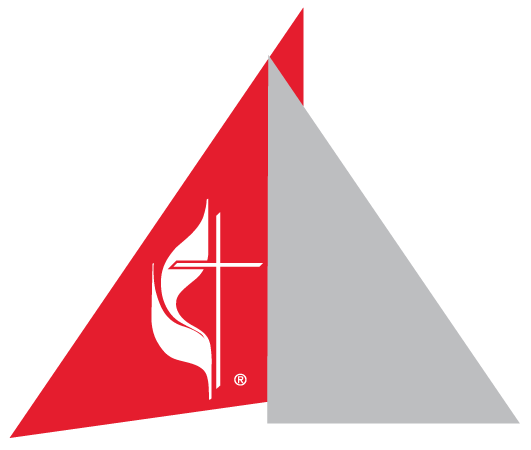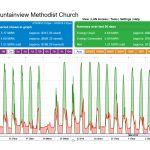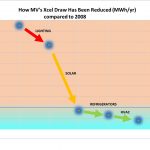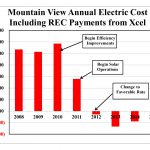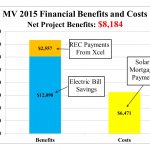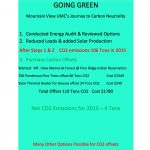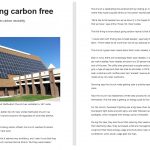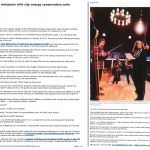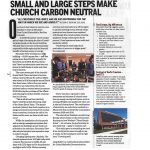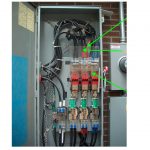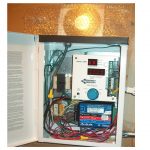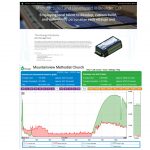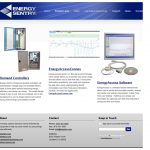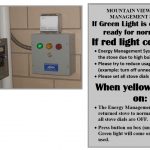Our Green Initiative
The Green Team at Mountain View promotes environmental stewardship actions within our building, within our community, and for our planet by working with Trustee and Outreach committees to become a greener church, as a community and as individuals. Please feel free to scroll through the following slideshow detailing our process towards becoming a greener church.
Solar Power – Live & Interactive!
Carbon Neutrality
Mountain View United Methodist Church is proud to be carbon neutral for 2016. Our carbon neutrality (our “carbon footprint,” the net amount of carbon dioxide the we put into the atmosphere from our energy usage, comes to zero) results from a combination of our solar panels, our energy conservation efforts, and our purchase of carbon credits through the planting of trees and solar projects on the Pine Ridge Indian Reservation.
Who We Are
Our church’s Green Earth Team focuses on promoting environmental stewardship actions within our building, within our community, and for our planet. We work with our church’s Trustees and Outreach committees to become a greener church, as a community as and individuals. Our ongoing goal is to continue to foster Christian environmental responsibility through ongoing discussions and events.
Facts
About Energy, Carbon Neutral Programs At Mountain View United Methodist.
- Mountain View United Methodist Church achieved carbon neutral status in summer 2016 following its purchase of carbon offsets and reducing its CO2 consumption by 110 tons.
- Purchase of carbon offsets in May 2016 was the final step in a five-year-long series of carbon-use reductions that allowed Mountain View to become carbon neutral in 2016.
- The congregation raised $1,780 to purchase 700 ponderosa pine trees for the Pine Ridge Reservation and for providing solar heat to the reservation, yielding 110 tons of carbon offset. Other carbon reductions were achieved over several years through the following changes to the building’s carbon footprint, focusing on reducing electricity consumption:
- Replaced all 229 magnetic ballasts in fluorescent lighting fixtures with electronic ballasts and replaced 492 T12 fluorescent tubes with high efficiency T8s.
- Replaced approximately 100 light bulbs with either compact fluorescents or LEDs.
- Replaced 26 building EXIT signs with LED signs.
- Upgraded light fixtures producing a 16 percent reduction in electricity consumption. Two-thirds of the cost of lighting upgrades was covered by Xcel Energy rebates. Lighting upgrades were installed by church volunteers over a six-month period.
- Replaced several refrigerators and one freezer with Energy Star rated models, reducing energy consumption from the appliances by more than 50 percent.
- Installed occupancy sensing switches in several church meeting rooms.
- Replaced 24 incandescent spotlights with LED spotlights.
- Conducted a church-wide educational program to raise awareness of energy-saving techniques, such as turning off lights and appliances when not in use, closing doors, etc.
- The combination of electricity use reductions resulted in a 36 percent drop in electricity consumption, from 75,000-kilowatt hours in 2008 to 48,100-kilowatt hours in 2015
- Following installation of 187 solar panels in 2010-11, the church produces 60,000-kilowatt hours a year, or 12,000-kilowatt hours more than the building’s annual consumption. Over the 25-year lifespan of the solar system, electricity cost savings have been estimated at $500,000.
- In 2008 the church was paying more than $10,000 annually for electricity. After Mountain View’s solar project became operational in mid-2011, it reduced the amount of electricity needed from Xcel Energy, earning the church 4.5 cents per kilowatt-hour produced.
- To ensure maximum energy savings from the solar panels, the church installed an energy management system in 2012 to maintain peak-load usage of less than 25-kilowatt hours. The energy management system automatically turns off appliances or single air conditioners for 15 minutes at a time to ensure peak use remains below 25-kilowatt hours. The energy management system has resulted in electricity savings of $7,000 annually.
- By deciding to become green, Mountain View earned $2,557 in payments from Xcel in 2015 and saved the $12,098 it would have paid for electricity, for total 2015 savings of $14,655.
- While natural gas consumption is harder to reduce, several changes have been made to reduce the increase in natural gas use, which powers two natural gas boilers for the church’s hot water heating system. The following improvements were made to reduce increases in natural gas consumption over time:
- Single pane windows were replaced with double pane windows in most parts of the building.
- Insulation rate R10 has been added to 300 feet of foundation walls to a depth of 2 feet. Insulation also was added between the hot water registers and the concrete foundation walls.
- Currently, insulation is being added to the inside of some building walls, including crawl spaces in non-public parts of the building.
- Mountain View UMC includes a small A-frame built in 1965 and a larger A-frame, lobby and educational wing built in 1967. The building covers approximately 43,000 square feet.
- To ensure maximum energy savings from the solar panels, the church installed an energy management system in 2012 to maintain peak-load usage of less than 25-kilowatt hours. The energy management system automatically turns off appliances or single air conditioners for 15 minutes at a time to ensure peak use remains below 25-kilowatt hours. The energy management system has resulted in electricity savings of $7,000 annually.
Facts
About Energy, Carbon Neutral Programs At Mountain View United Methodist.
- Mountain View United Methodist Church achieved carbon neutral status in summer 2016 following its purchase of carbon offsets and reducing its CO2 consumption by 110 tons.
- Purchase of carbon offsets in May 2016 was the final step in a five-year-long series of carbon-use reductions that allowed Mountain View to become carbon neutral in 2016.
- The congregation raised $1,780 to purchase 700 ponderosa pine trees for the Pine Ridge Reservation and for providing solar heat to the reservation, yielding 110 tons of carbon offset. Other carbon reductions were achieved over several years through the following changes to the building’s carbon footprint, focusing on reducing electricity consumption:
- Replaced all 229 magnetic ballasts in fluorescent lighting fixtures with electronic ballasts and replaced 492 T12 fluorescent tubes with high efficiency T8s.
- Replaced approximately 100 light bulbs with either compact fluorescents or LEDs.
- Replaced 26 building EXIT signs with LED signs.
- Upgraded light fixtures producing a 16 percent reduction in electricity consumption. Two-thirds of the cost of lighting upgrades was covered by Xcel Energy rebates. Lighting upgrades were installed by church volunteers over a six-month period.
- Replaced several refrigerators and one freezer with Energy Star rated models, reducing energy consumption from the appliances by more than 50 percent.
- Installed occupancy sensing switches in several church meeting rooms.
- Replaced 24 incandescent spotlights with LED spotlights.
- Conducted a church-wide educational program to raise awareness of energy-saving techniques, such as turning off lights and appliances when not in use, closing doors, etc.
- The combination of electricity use reductions resulted in a 36 percent drop in electricity consumption, from 75,000-kilowatt hours in 2008 to 48,100-kilowatt hours in 2015
- Following installation of 187 solar panels in 2010-11, the church produces 60,000-kilowatt hours a year, or 12,000-kilowatt hours more than the building’s annual consumption. Over the 25-year lifespan of the solar system, electricity cost savings have been estimated at $500,000.
- In 2008 the church was paying more than $10,000 annually for electricity. After Mountain View’s solar project became operational in mid-2011, it reduced the amount of electricity needed from Xcel Energy, earning the church 4.5 cents per kilowatt-hour produced.
- To ensure maximum energy savings from the solar panels, the church installed an energy management system in 2012 to maintain peak-load usage of less than 25-kilowatt hours. The energy management system automatically turns off appliances or single air conditioners for 15 minutes at a time to ensure peak use remains below 25-kilowatt hours. The energy management system has resulted in electricity savings of $7,000 annually.
- By deciding to become green, Mountain View earned $2,557 in payments from Xcel in 2015 and saved the $12,098 it would have paid for electricity, for total 2015 savings of $14,655.
- While natural gas consumption is harder to reduce, several changes have been made to reduce the increase in natural gas use, which powers two natural gas boilers for the church’s hot water heating system. The following improvements were made to reduce increases in natural gas consumption over time:
- Single pane windows were replaced with double pane windows in most parts of the building.
- Insulation rate R10 has been added to 300 feet of foundation walls to a depth of 2 feet. Insulation also was added between the hot water registers and the concrete foundation walls.
- Currently, insulation is being added to the inside of some building walls, including crawl spaces in non-public parts of the building.
- Mountain View UMC includes a small A-frame built in 1965 and a larger A-frame, lobby and educational wing built in 1967. The building covers approximately 43,000 square feet.
- To ensure maximum energy savings from the solar panels, the church installed an energy management system in 2012 to maintain peak-load usage of less than 25-kilowatt hours. The energy management system automatically turns off appliances or single air conditioners for 15 minutes at a time to ensure peak use remains below 25-kilowatt hours. The energy management system has resulted in electricity savings of $7,000 annually.

